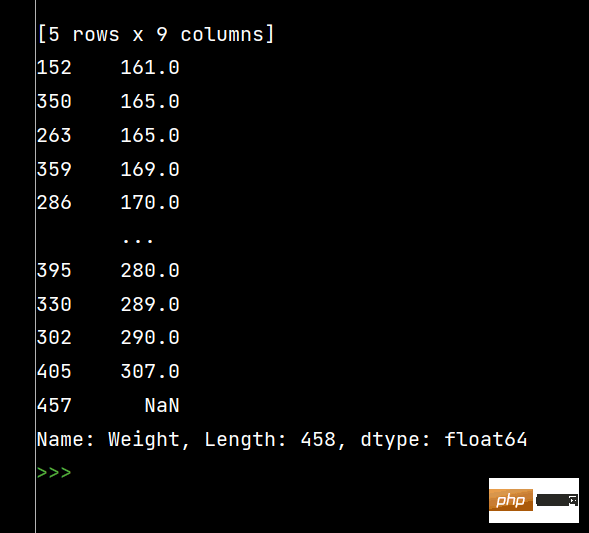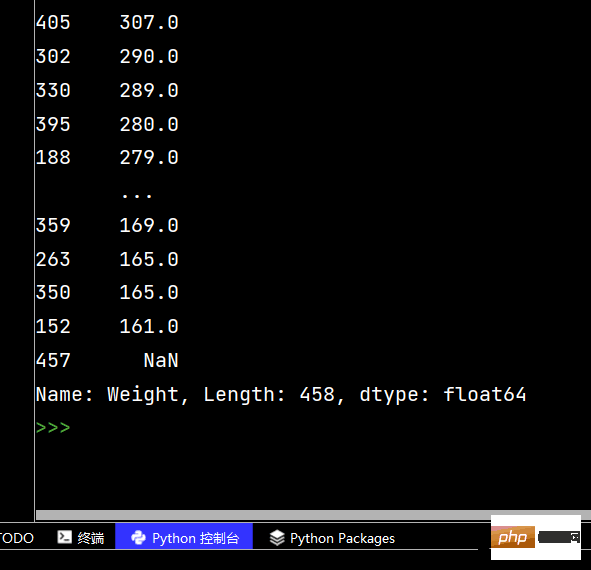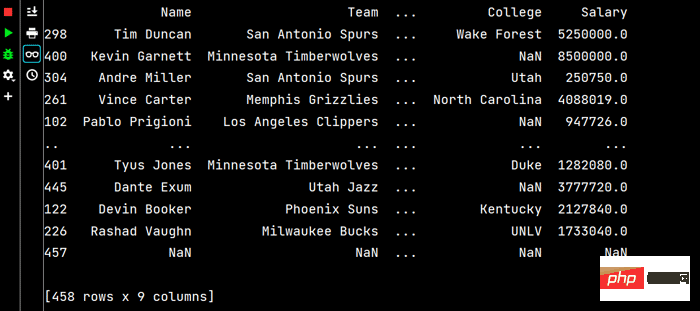 Backend-Entwicklung
Backend-Entwicklung
 Python-Tutorial
Python-Tutorial
 Beispielanalyse für die mathematische Modellierung von Python
Beispielanalyse für die mathematische Modellierung von Python
Beispielanalyse für die mathematische Modellierung von Python
SciPy-Lernen
''' SciPy 包含的模块有最优化、线性代数、积分、插值、特殊函数、快速傅里叶变换、 信号处理和图像处理、常微分方程求解和其他科学与工程中常用的计算。 ''' # 安装scipy库: # SciPy终端安装命令:pip install SciPy # https://www.runoob.com/w3cnote/python-pip-install-usage.html Python pip 安装与使用 # 查看scipy版本: import scipy print(scipy.__version__) # SciPy模块功能表 ''' 模块 功能 scipy.cluster 聚类分析等 scipy.constants 物理和数学函数 scipy.fftpack 傅里叶变换 scipy.integrate 积分 scipy.interpolate 插值 scipy.io 数据输入和输出 scipy.linalg 线性代数 scipy.ndimage n维图像 scipy.odr 正交距离回归 scipy.optimize 优化 scipy.signal 信号处理 scipy.sparse 稀疏矩阵 scipy.spatial 空间数据结构和算法 scipy.special 特殊函数 scipy.stats 统计 ''' # 使用 dir() 函数来查看 constants 模块包含的常量: from scipy import constants print(dir(constants)) ''' 单位类型 常量模块包含以下几种单位: 公制单位 二进制,以字节为单位 质量单位 角度换算 时间单位 长度单位 压强单位 体积单位 速度单位 温度单位 能量单位 功率单位 力学单位 ''' print() # SciPy 常量模块: # constants 是 scipy 的常量模块 from scipy import constants # 查看一英亩等于多少平方米: print(constants.acre) # 输出 4046.8564223999992 # SciPy 常量模块 constants 提供了许多内置的数学常数 # 圆周率: pi # 黄金比例: golden from scipy import constants print(constants.pi) # 输出 3.141592653589793 【圆周率】 print(constants.golden) # 输出 1.618033988749895 【黄金比例】
SciPy-Grundoperationen
1-Lösen Sie nichtlineare Gleichungen (Satz)
1-1

Der Lösungscode lautet wie folgt:
# scipy.optimize模块的fsolve和root可求非线性方程(组)的解
# 格式:
from scipy.optimize import fsolve
from scipy.optimize import root
# fsolve或root求解非线性方程组时,先把非线性方程组写成 F(x)=0 这样的形式【x:向量;F(x):向量函数】
fx = lambda x: x**980-5.01*x**979-3.388*x**977\
+7.398*x**978-x**3+5.01*x**2-7.398*x+3.388
x1 = fsolve(fx, 1.5, maxfev=420) # 函数调用420次【调用小了,会报警告】
x2 = root(fx, 1.5)
print(x1) # 相当于答案
print()
print(x2) # 相当于解题过程Der Ergebnisse der Ausführung von x1 und x2 sind wie folgt:

1-2

Der Lösungscode lautet wie folgt:
from scipy.optimize import fsolve, root fs2 = lambda s: [s[0]**2+s[1]**2-1, s[0]-s[1]] s1 = fsolve(fs2, [1, 1]) print() s2 = root(fs2, [1, 1]) print(s1) # 输出 [0.70710678 0.70710678] print() print(s2)
Die Auswirkung der Ausführung von s2 ist wie folgt:

2 -Punkte
Das scipy.integrate-Modul bietet mehrere Punktemodi.
Integral wird hauptsächlich in die folgenden zwei Kategorien unterteilt:
Numerische Integration einer gegebenen Funktion
Numerische Integration eines gegebenen diskreten Punktes, die Funktion hat Trapz
Frage:

'''
函数 说明
quad(func, a, b, args) 计算一重数值积分
dblquad(func, a, b, gfun, hfun, args) 计算二重数值积分
tplquad(func, a, b, gfun, hfun, qfun, rfun) 计算三重数值积分
nquad(func, ranges, args) 计算多变量积分
'''
from scipy.integrate import quad
def func(x, a, b):
return a*x**2+b*x
z1 = quad(func, 0, 1, args=(2, 1))
z2 = quad(func, 0, 1, args=(2, 10))
print(z1) # 输出 (1.1666666666666665, 1.2952601953960159e-14)
print(z2) # 输出 (5.666666666666667, 6.291263806209221e-14)
# 注:输出的后一个值为积分值的绝对误差3-Lösung der kleinsten Quadrate

# 最小二乘解 # scipy.optimize 模块求非线性方程组最小二乘解格式: ''' from scipy.optimize import least_squares least_squares(fun, x0) 注:用到loadtxt需自行准备好文件【准备文件】 ''' from scipy.optimize import least_squares import numpy as np s = np.loadtxt('data.txt') x0 = s[0] y0 = s[1] d = s[2] fs = lambda x: np.sqrt((x0-s[0])**2+(y0-s[1])**2-d) xc = least_squares(fs, np.random.rand(2)) print(xc) print() print(xc.s)
4-maximaler modularer Eigenwert und entsprechender Eigenvektor
Frage:

# 4-最大模特征值及对应的特征向量
# 题目描述:求下列矩阵的最大模特征值及对应的特征向量:
from scipy.sparse.linalg import eigs
import numpy as np
m = np.array([
[1, 2, 3],
[2, 1, 3],
[3, 3, 6]
], dtype=float)
a, b = np.linalg.eig(m)
c, d = eigs(m, 1)
print('最大模特征值为:', c) # 输出 最大模特征值为: [9.+0.j]
print('对应的特征向量:\n', d)Die laufenden Ergebnisse sind wie folgt:

Numpy-Lernen (Fortsetzung)
# NumPy 广播(Broadcast)
# 广播是 numpy 对不同形状的数组进行数值计算的方式, 对数组的算术运算通常在相应的元素上进行。
# 如果两个数组 a 和 b 形状相同,即满足 a.shape == b.shape,那么 a*b 的结果就是 a 与 b 数组对应位相乘。
# 这要求维数相同,且各维度的长度相同。
'''
对两个数组,分别比较他们的每一个维度(若其中一个数组没有当前维度则忽略),满足:
数组拥有相同形状。
当前维度的值相等。
当前维度的值有一个是 1。
若条件不满足,抛出 "ValueError: frames are not aligned" 异常
'''
import numpy as np
a = np.array([3, 6, 9])
b = np.array([2, 4, 6])
c = a * b
print(c) # 输出 [ 6 24 54]
# 若形状不同时,numpy 将自动触发广播机制
import numpy as np
x = np.array([
[4, 2, 5],
[5, 2, 0],
[2, 6, 1],
[1, 4, 5]
])
y = np.array([3, 1, 2])
print(x+y)
yy = np.tile(y, (4, 1)) # 重复b的各个维度
print(x+yy)1 Numpy-mathematische Funktionen
1-1 trigonometrische Funktion
# NumPy 数学函数 # NumPy 包含大量的各种数学运算的函数,包括三角函数,算术运算的函数,复数处理函数等。 # 1-三角函数 # NumPy 提供了标准的三角函数:sin()、cos()、tan()。 import numpy as np lxw = np.array([0, 30, 45, 60, 90]) # sin() zx = np.sin(lxw*np.pi/180) print(zx) # 计算角度的反正弦【单位:弧度】 fzx = np.arcsin(zx) print(fzx) # 检查结果【通过转化为角度制】 jg = np.degrees(fzx) print(jg) # 输出 [ 0. 30. 45. 60. 90.] # cos() yx = np.cos(lxw*np.pi/180) print(yx) # 反余弦 fyx = np.arccos(yx) print(fyx) # 检查结果: jg2 = np.degrees(fyx) print(jg2) # 输出 [ 0. 30. 45. 60. 90.] # tan() zq = np.tan(lxw*np.pi/180) print(zq) # 反正切 fzq = np.arctan(zq) print(fzq) # 检查结果: jg3 = np.degrees(fzq) print(jg3) # 输出 [ 0. 30. 45. 60. 90.]
2-Rundungsfunktion
2-1 numpy.around()
# 2-舍入函数 # 2-1 numpy.around() ''' numpy.around() 函数返回指定数字的四舍五入值。 格式: numpy.around(a,decimals) 参数说明: a: 数组 decimals: 舍入的小数位数。 默认值为0。 如果为负,整数将四舍五入到小数点左侧的位置 ''' import numpy as np bl = np.array([15.222, 22.6555, 13.71111]) print(np.around(bl)) # 输出 [15. 23. 14.] print(np.around(bl, 2)) # 输出 [15.22 22.66 13.71] print(np.around(bl, -1)) # 输出 [20. 20. 10.]
2-2 numpy.floor()
# 2-2 numpy.floor() # numpy.floor() 返回小于或者等于指定表达式的最大整数,即向下取整 import numpy as np xx = np.array([23.3, 13.43, 2.9]) print(np.floor(xx)) # 输出 [23. 13. 2.]
2-3 numpy.ceil()
# 2-3 numpy.ceil() # numpy.ceil() 返回大于或者等于指定表达式的最小整数,即向上取整 import numpy as np xs = np.array([23.1, 23.5, 54.9]) print(np.ceil(xs)) # 输出 [24. 24. 55.]
3 Numpy-Arithmetikfunktionen
NumPy-Arithmetikfunktionen umfassen einfache Addition, Subtraktion, Multiplikation und Division: add(), subtract(), multiply() und Divide()
-
reciprocal :reciprocal()
power: power()
rest: mod() |. rest()
Hinweis: Die Arrays müssen die gleiche Form haben oder < /code>Array-Broadcasting-Regeln einhalten<code>注:数组必须具有相同的形状或符合数组广播规则
相关代码如下:
import numpy as np sz = np.arange(9, dtype=np.float_).reshape(3, 3) sz2 = np.array([5, 2, 1]) # 注:如果相除,这里是被除数的话,里面不能有0 # 数组相加 xj = np.add(sz, sz2) print(xj) # 数组相减 xj2 = np.subtract(sz, sz2) print(xj2) # 数组相乘 xc = np.multiply(sz, sz2) print(xc) # 数组相除 xc2 = np.divide(sz, sz2) print(xc2) print() # numpy.power() # numpy.power() 函数将第一个输入数组中的元素作为底数,计算它与第二个输入数组中相应元素的幂 import numpy as np m = np.array([1, 4, 8]) # 数组1 mc = np.power(m, 3) # 数组1所有元素对应的3次方 print(mc) # 输出 [ 1 64 512] m2 = np.array([1, 2, 3]) # 数组2 mc2 = np.power(m, m2) # 数组1作为底数,数组2作为幂 print(mc2) # 输出 [ 1 16 512] print() # numpy.mod() # numpy.mod() 计算输入数组中相应元素的相除后的余数 # 函数 numpy.remainder() 也产生相同的结果 import numpy as np sz1 = np.array([23, 45, 67]) sz2 = np.array([2, 3, 5]) print(np.mod(sz1, sz2)) # 输出 [1 0 2] print(np.remainder(sz1, sz2)) # 输出 [1 0 2]
Pandas学习(续)
# pandas的SettingWithCopyWarning
# pandas的SettingWithCopyWarning报警复现、原因、解决方案 # 读取数据 import pandas as pd df = pd.read_csv('nba.csv') print(df.head()) # 核心解决问题:pandas的dataframe的修改写操作,只允许在源dataframe上进行,一步到位 # 解决方法(两种): ''' 1-将get+set的两步操作,改成set的一步操作 2-若须处理筛选数据做后续的处理分析,使用copy复制dataframe ''' # pandas不允许先筛选子dataframe,在进行修改写入
【注意先准备好csv文件
Der relevante Code lautet wie folgt:
# Pandas 数据排序
'''
Series的排序:
Series.sort_values(ascending=True, inplace=False)
参数说明:
· ascending: 默认为True升序排序,False为False
· inplace: 是否修改原始Series
DataFrame的排序:
DataFrame.sort_values(by, ascending=True, inplace=False)
参数说明:
· by:字符串或者List<字符串>,单列排序或者多列排序
· ascending: bool或者List,升序还是降序
· inplace: 是否修改原始DataFrame
'''
# Series的排序:
import pandas as pd
df = pd.read_csv('nba.csv')
print(df.head()) # 输出前五行
print(df['Weight'].sort_values()) # 升序排序
print(df['Weight'].sort_values(ascending=False)) # 降序排序# SettingWithCopyWarning of Pandas
# DataFrame的排序 # 单列排序: print(df.sort_values(by='Weight'))
Bereiten Sie sorgfältig vor csv-Datei zuerst]  Pandas-Datensortierung
Pandas-Datensortierung
 Seriensortierung:
Seriensortierung:
print(df.sort_values(by="Weight", ascending=False)) # 降序排序
 Die laufenden Ergebnisse sind wie folgt:
Die laufenden Ergebnisse sind wie folgt: 

# 多列排序: print(df.sort_values(by=['Age', 'Weight']))
 Laufen Teil Die Ergebnisse sind wie folgt:
Laufen Teil Die Ergebnisse sind wie folgt: 

# 两个字段都是降序排序 print(df.sort_values(by=['Age', 'Weight'], ascending=False))
# 分别指定升序还是降序 print(df.sort_values(by=['Age', 'Weight'], ascending=[False, True]))
df['lrl'].str.replace("%", "").astype("int32")
# Pandas字符串处理: ''' 1-使用方法:先获取Series的属性,然后再属性上调用函数 2-只能在字符串列上使用,不能再数字列上使用 3-DataFrame没有str属性和使用 4-Series.str并不是原生Python字符串,它是封装的一套方法 ''' # 获取Series的属性 # print(df['Salary'].str) # 报错【示范】 # AttributeError: Can only use .str accessor with string values! # AttributeError:只能使用。带字符串值的str访问器! # 一定得是字符串列 print(df['College'].str) # 运行结果为: <pandas.core.strings.accessor.StringMethods object at 0x00000204444EBC48> # 判断是不是数字列 print(df['College'].str.isnumeric()) # print(df['College'].len) # 报错【示范】 # AttributeError: 'Series' object has no attribute 'len' # AttributeError:“Series”对象没有属性“len”

 Pandas String-Verarbeitung
Pandas String-Verarbeitung
Ich hatte einige Probleme mit dieser String-Verarbeitung Problem schon einmal (aber ich habe es so gelöst Tag) [Schau es dir heute an
Das obige ist der detaillierte Inhalt vonBeispielanalyse für die mathematische Modellierung von Python. Für weitere Informationen folgen Sie bitte anderen verwandten Artikeln auf der PHP chinesischen Website!

Heiße KI -Werkzeuge

Undresser.AI Undress
KI-gestützte App zum Erstellen realistischer Aktfotos

AI Clothes Remover
Online-KI-Tool zum Entfernen von Kleidung aus Fotos.

Undress AI Tool
Ausziehbilder kostenlos

Clothoff.io
KI-Kleiderentferner

AI Hentai Generator
Erstellen Sie kostenlos Ai Hentai.

Heißer Artikel

Heiße Werkzeuge

Notepad++7.3.1
Einfach zu bedienender und kostenloser Code-Editor

SublimeText3 chinesische Version
Chinesische Version, sehr einfach zu bedienen

Senden Sie Studio 13.0.1
Leistungsstarke integrierte PHP-Entwicklungsumgebung

Dreamweaver CS6
Visuelle Webentwicklungstools

SublimeText3 Mac-Version
Codebearbeitungssoftware auf Gottesniveau (SublimeText3)

Heiße Themen
 1378
1378
 52
52
 Hadidb: Eine leichte, horizontal skalierbare Datenbank in Python
Apr 08, 2025 pm 06:12 PM
Hadidb: Eine leichte, horizontal skalierbare Datenbank in Python
Apr 08, 2025 pm 06:12 PM
Hadidb: Eine leichte, hochrangige skalierbare Python-Datenbank Hadidb (HadIDB) ist eine leichte Datenbank in Python mit einem hohen Maß an Skalierbarkeit. Installieren Sie HadIDB mithilfe der PIP -Installation: PipinstallHadIDB -Benutzerverwaltung erstellen Benutzer: createUser (), um einen neuen Benutzer zu erstellen. Die Authentication () -Methode authentifiziert die Identität des Benutzers. fromHadidb.operationImportUseruser_obj = user ("admin", "admin") user_obj.
 Python: Erforschen der primären Anwendungen
Apr 10, 2025 am 09:41 AM
Python: Erforschen der primären Anwendungen
Apr 10, 2025 am 09:41 AM
Python wird in den Bereichen Webentwicklung, Datenwissenschaft, maschinelles Lernen, Automatisierung und Skripten häufig verwendet. 1) In der Webentwicklung vereinfachen Django und Flask Frameworks den Entwicklungsprozess. 2) In den Bereichen Datenwissenschaft und maschinelles Lernen bieten Numpy-, Pandas-, Scikit-Learn- und TensorFlow-Bibliotheken eine starke Unterstützung. 3) In Bezug auf Automatisierung und Skript ist Python für Aufgaben wie automatisiertes Test und Systemmanagement geeignet.
 Der 2-stündige Python-Plan: ein realistischer Ansatz
Apr 11, 2025 am 12:04 AM
Der 2-stündige Python-Plan: ein realistischer Ansatz
Apr 11, 2025 am 12:04 AM
Sie können grundlegende Programmierkonzepte und Fähigkeiten von Python innerhalb von 2 Stunden lernen. 1. Lernen Sie Variablen und Datentypen, 2. Master Control Flow (bedingte Anweisungen und Schleifen), 3.. Verstehen Sie die Definition und Verwendung von Funktionen, 4. Beginnen Sie schnell mit der Python -Programmierung durch einfache Beispiele und Code -Snippets.
 Navicat -Methode zum Anzeigen von MongoDB -Datenbankkennwort
Apr 08, 2025 pm 09:39 PM
Navicat -Methode zum Anzeigen von MongoDB -Datenbankkennwort
Apr 08, 2025 pm 09:39 PM
Es ist unmöglich, das MongoDB -Passwort direkt über Navicat anzuzeigen, da es als Hash -Werte gespeichert ist. So rufen Sie verlorene Passwörter ab: 1. Passwörter zurücksetzen; 2. Überprüfen Sie die Konfigurationsdateien (können Hash -Werte enthalten). 3. Überprüfen Sie Codes (May Hardcode -Passwörter).
 Wie man AWS -Kleber mit Amazon Athena verwendet
Apr 09, 2025 pm 03:09 PM
Wie man AWS -Kleber mit Amazon Athena verwendet
Apr 09, 2025 pm 03:09 PM
Als Datenprofi müssen Sie große Datenmengen aus verschiedenen Quellen verarbeiten. Dies kann Herausforderungen für das Datenmanagement und die Analyse darstellen. Glücklicherweise können zwei AWS -Dienste helfen: AWS -Kleber und Amazon Athena.
 Wie optimieren Sie die MySQL-Leistung für Hochlastanwendungen?
Apr 08, 2025 pm 06:03 PM
Wie optimieren Sie die MySQL-Leistung für Hochlastanwendungen?
Apr 08, 2025 pm 06:03 PM
Die MySQL-Datenbankleistung Optimierungshandbuch In ressourcenintensiven Anwendungen spielt die MySQL-Datenbank eine entscheidende Rolle und ist für die Verwaltung massiver Transaktionen verantwortlich. Mit der Erweiterung der Anwendung werden jedoch die Datenbankleistung Engpässe häufig zu einer Einschränkung. In diesem Artikel werden eine Reihe effektiver Strategien zur Leistungsoptimierung von MySQL -Leistung untersucht, um sicherzustellen, dass Ihre Anwendung unter hohen Lasten effizient und reaktionsschnell bleibt. Wir werden tatsächliche Fälle kombinieren, um eingehende Schlüsseltechnologien wie Indexierung, Abfrageoptimierung, Datenbankdesign und Caching zu erklären. 1. Das Design der Datenbankarchitektur und die optimierte Datenbankarchitektur sind der Eckpfeiler der MySQL -Leistungsoptimierung. Hier sind einige Kernprinzipien: Die Auswahl des richtigen Datentyps und die Auswahl des kleinsten Datentyps, der den Anforderungen entspricht, kann nicht nur Speicherplatz speichern, sondern auch die Datenverarbeitungsgeschwindigkeit verbessern.
 So starten Sie den Server mit Redis
Apr 10, 2025 pm 08:12 PM
So starten Sie den Server mit Redis
Apr 10, 2025 pm 08:12 PM
Zu den Schritten zum Starten eines Redis -Servers gehören: Installieren von Redis gemäß dem Betriebssystem. Starten Sie den Redis-Dienst über Redis-Server (Linux/macOS) oder redis-server.exe (Windows). Verwenden Sie den Befehl redis-cli ping (linux/macOS) oder redis-cli.exe ping (Windows), um den Dienststatus zu überprüfen. Verwenden Sie einen Redis-Client wie Redis-Cli, Python oder Node.js, um auf den Server zuzugreifen.
 So lesen Sie Redis -Warteschlange
Apr 10, 2025 pm 10:12 PM
So lesen Sie Redis -Warteschlange
Apr 10, 2025 pm 10:12 PM
Um eine Warteschlange aus Redis zu lesen, müssen Sie den Warteschlangenname erhalten, die Elemente mit dem Befehl LPOP lesen und die leere Warteschlange verarbeiten. Die spezifischen Schritte sind wie folgt: Holen Sie sich den Warteschlangenname: Nennen Sie ihn mit dem Präfix von "Warteschlange:" wie "Warteschlangen: My-Queue". Verwenden Sie den Befehl LPOP: Wischen Sie das Element aus dem Kopf der Warteschlange aus und geben Sie seinen Wert zurück, z. B. die LPOP-Warteschlange: my-queue. Verarbeitung leerer Warteschlangen: Wenn die Warteschlange leer ist, gibt LPOP NIL zurück, und Sie können überprüfen, ob die Warteschlange existiert, bevor Sie das Element lesen.



